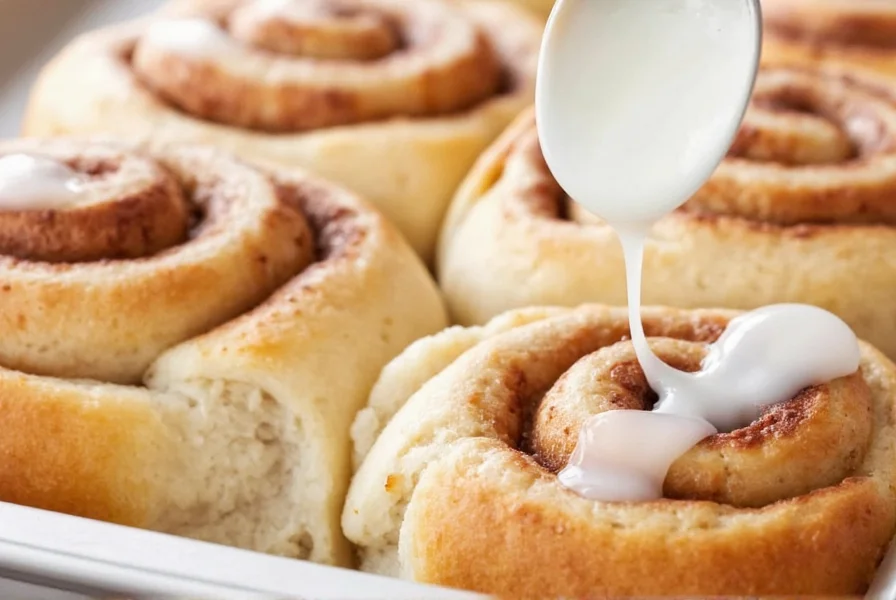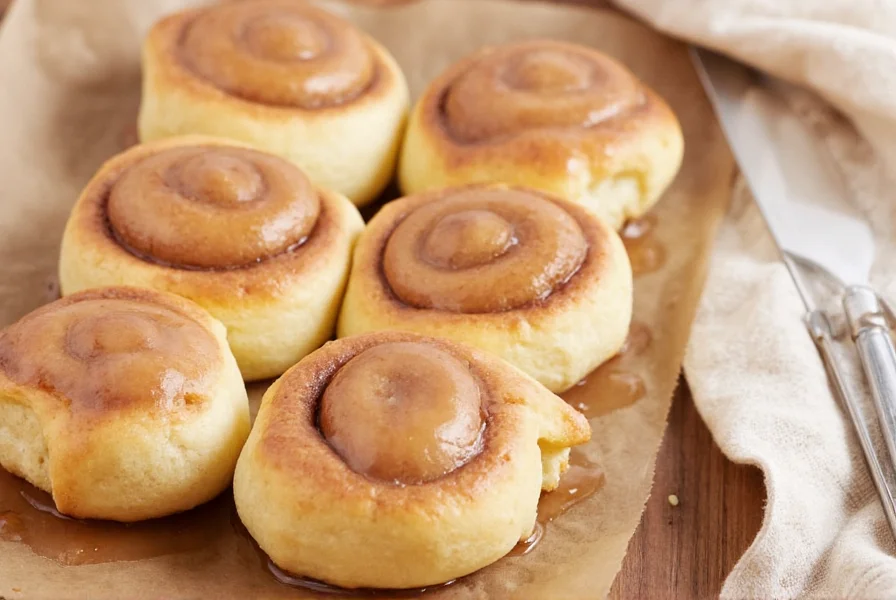Creating the perfect glaze for cinnamon rolls transforms a good pastry into an exceptional treat. The right glaze should enhance, not dominate, the delicate balance of cinnamon and dough. While variations exist, the classic powdered sugar glaze remains the most popular choice for its simplicity and crowd-pleasing flavor profile.
Essential Components of Cinnamon Roll Glaze
A successful glaze requires careful attention to its fundamental elements. The base typically consists of powdered sugar, which dissolves smoothly without graininess. Liquid components like milk, cream, or alternative dairy-free options control consistency. Fat sources such as butter add richness, while flavor enhancers like vanilla or citrus zest provide depth.
Temperature matters significantly—applying glaze to warm (not hot) cinnamon rolls allows proper absorption without melting away. The ideal glaze should coat the back of a spoon but still flow smoothly when poured.
Classic Powdered Sugar Glaze Recipe
This straightforward recipe yields enough glaze for one standard 9x13 inch pan of cinnamon rolls:
| Ingredient | Amount | Function |
|---|---|---|
| Powdered sugar (confectioners' sugar) | 1 cup | Base sweetener that dissolves smoothly |
| Milk or cream | 2-3 tablespoons | Liquid component for proper consistency |
| Unsalted butter, melted | 2 tablespoons | Adds richness and helps glaze adhere |
| Vanilla extract | 1/2 teaspoon | Flavor enhancer |
| Salt | Pinch | Balances sweetness |
Instructions: Whisk all ingredients together until completely smooth. Adjust consistency by adding more liquid (1 teaspoon at a time) if too thick, or more powdered sugar if too thin. Pour over warm cinnamon rolls immediately after baking.
Cream Cheese Glaze Alternative
For those preferring a tangier profile, cream cheese glaze offers a delicious variation:
- 4 ounces cream cheese, softened
- 1/4 cup unsalted butter, softened
- 1 1/2 cups powdered sugar
- 1/4 teaspoon vanilla extract
- 1-2 tablespoons milk
- Pinch of salt
Beat cream cheese and butter until smooth, then gradually add powdered sugar. Mix in vanilla, salt, and enough milk to reach desired consistency. This glaze works particularly well with richer cinnamon roll recipes.
Popular Glaze Variations
Experiment with these creative twists on traditional glaze:
| Variation | Key Ingredients | Best Paired With |
|---|---|---|
| Maple Glaze | Replace milk with pure maple syrup | Nut-filled or whole grain cinnamon rolls |
| Lemon Glaze | Add 1 tablespoon lemon zest + 1-2 tablespoons lemon juice | Lighter, less sweet cinnamon roll recipes |
| Brown Butter Glaze | Substitute regular butter with browned butter | Rich, buttery cinnamon roll dough |
| Spiced Glaze | Add 1/4 teaspoon cinnamon or pumpkin spice | Fall-inspired cinnamon roll variations |
Troubleshooting Common Glaze Problems
Even experienced bakers encounter glaze issues. Here's how to fix them:
- Glaze too thin: Add additional powdered sugar, 1 tablespoon at a time, until desired consistency.
- Glaze too thick: Incorporate additional liquid (milk, cream, or alternative) in 1/2 teaspoon increments.
- Glaze separates: This usually happens when ingredients are at different temperatures. Ensure all components are at room temperature before mixing.
- Glaze sets too quickly: Work with warmer cinnamon rolls or add slightly more liquid to the glaze mixture.
- Glaze doesn't adhere: Apply to warm (not hot) rolls and ensure proper butter content in the glaze.
Application Techniques for Perfect Coverage
How you apply glaze affects both appearance and flavor distribution:
- Allow cinnamon rolls to cool for 5-10 minutes after baking (still warm but not steaming)
- Use a spoon or small pitcher for controlled pouring
- Start from the center and work outward for even distribution
- For thicker glazes, use an offset spatula to gently spread
- Let glaze set for 10-15 minutes before serving for clean slices
For restaurant-style presentation, consider drizzling additional glaze in a zig-zag pattern after the initial layer has set slightly.
Storage and Serving Recommendations
Glazed cinnamon rolls are best enjoyed the day they're made. Store leftovers in an airtight container at room temperature for up to 2 days. For longer storage, freeze unglazed rolls and add fresh glaze after reheating.
When reheating, place rolls on a baking sheet and warm in a 300°F oven for 5-7 minutes before adding fresh glaze. This technique restores the ideal texture for glaze absorption.

Ingredient Substitutions for Dietary Needs
Adapt your glaze for various dietary requirements without sacrificing quality:
- Dairy-free: Substitute milk with almond, oat, or coconut milk; use vegan butter
- Gluten-free: Ensure powdered sugar is certified gluten-free (some contain cornstarch)
- Lower sugar: Reduce powdered sugar by 1/4 cup and add 1-2 tablespoons of Greek yogurt
- Vegan: Combine dairy-free milk, vegan butter, and powdered sugar
When making substitutions, adjust liquid content carefully as alternative ingredients often have different absorption properties.
Can I make cinnamon roll glaze without powdered sugar?
Yes, you can create a simple glaze using 1/2 cup granulated sugar, 2 tablespoons cornstarch, 1/2 cup milk, and 2 tablespoons butter. Cook over medium heat until thickened, then cool slightly before adding 1/2 teaspoon vanilla. This stovetop version works well but has a different texture than traditional powdered sugar glaze.
How do I prevent my glaze from becoming grainy?
Graininess typically occurs when powdered sugar isn't fully incorporated or when liquid is added too quickly. To prevent this, sift your powdered sugar before mixing, add liquid gradually while whisking constantly, and ensure all ingredients are at room temperature. If your glaze does become grainy, try gently warming the mixture over a double boiler while whisking until smooth.
Why does my glaze soak into the cinnamon rolls too quickly?
This happens when rolls are too hot when glaze is applied. Allow rolls to cool for 5-10 minutes after baking so the surface sets slightly. Your glaze might also be too thin—adjust by adding more powdered sugar. The ideal temperature for glazing is when rolls are warm to the touch but not steaming (approximately 120-140°F).
Can I make cinnamon roll glaze ahead of time?
Yes, you can prepare glaze up to 24 hours in advance. Store in an airtight container at room temperature with plastic wrap pressed directly onto the surface to prevent drying. If the glaze thickens too much, whisk in additional milk (1/2 teaspoon at a time) to restore proper consistency before using.
What's the difference between icing and glaze for cinnamon rolls?
While often used interchangeably, there are subtle differences. Glaze typically has a thinner consistency that soaks slightly into the pastry, made primarily with powdered sugar and liquid. Icing is usually thicker, often containing more butter or cream cheese, and sits more prominently on top of the rolls. Glaze sets softer, while icing develops a firmer crust.
Frequently Asked Questions
Can I make cinnamon roll glaze without powdered sugar?
Yes, you can create a simple glaze using 1/2 cup granulated sugar, 2 tablespoons cornstarch, 1/2 cup milk, and 2 tablespoons butter. Cook over medium heat until thickened, then cool slightly before adding 1/2 teaspoon vanilla. This stovetop version works well but has a different texture than traditional powdered sugar glaze.
How do I prevent my glaze from becoming grainy?
Graininess typically occurs when powdered sugar isn't fully incorporated or when liquid is added too quickly. To prevent this, sift your powdered sugar before mixing, add liquid gradually while whisking constantly, and ensure all ingredients are at room temperature. If your glaze does become grainy, try gently warming the mixture over a double boiler while whisking until smooth.
Why does my glaze soak into the cinnamon rolls too quickly?
This happens when rolls are too hot when glaze is applied. Allow rolls to cool for 5-10 minutes after baking so the surface sets slightly. Your glaze might also be too thin—adjust by adding more powdered sugar. The ideal temperature for glazing is when rolls are warm to the touch but not steaming (approximately 120-140°F).
Can I make cinnamon roll glaze ahead of time?
Yes, you can prepare glaze up to 24 hours in advance. Store in an airtight container at room temperature with plastic wrap pressed directly onto the surface to prevent drying. If the glaze thickens too much, whisk in additional milk (1/2 teaspoon at a time) to restore proper consistency before using.
What's the difference between icing and glaze for cinnamon rolls?
While often used interchangeably, there are subtle differences. Glaze typically has a thinner consistency that soaks slightly into the pastry, made primarily with powdered sugar and liquid. Icing is usually thicker, often containing more butter or cream cheese, and sits more prominently on top of the rolls. Glaze sets softer, while icing develops a firmer crust.











 浙公网安备
33010002000092号
浙公网安备
33010002000092号 浙B2-20120091-4
浙B2-20120091-4